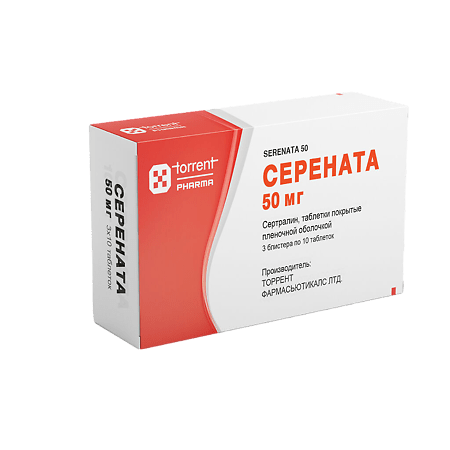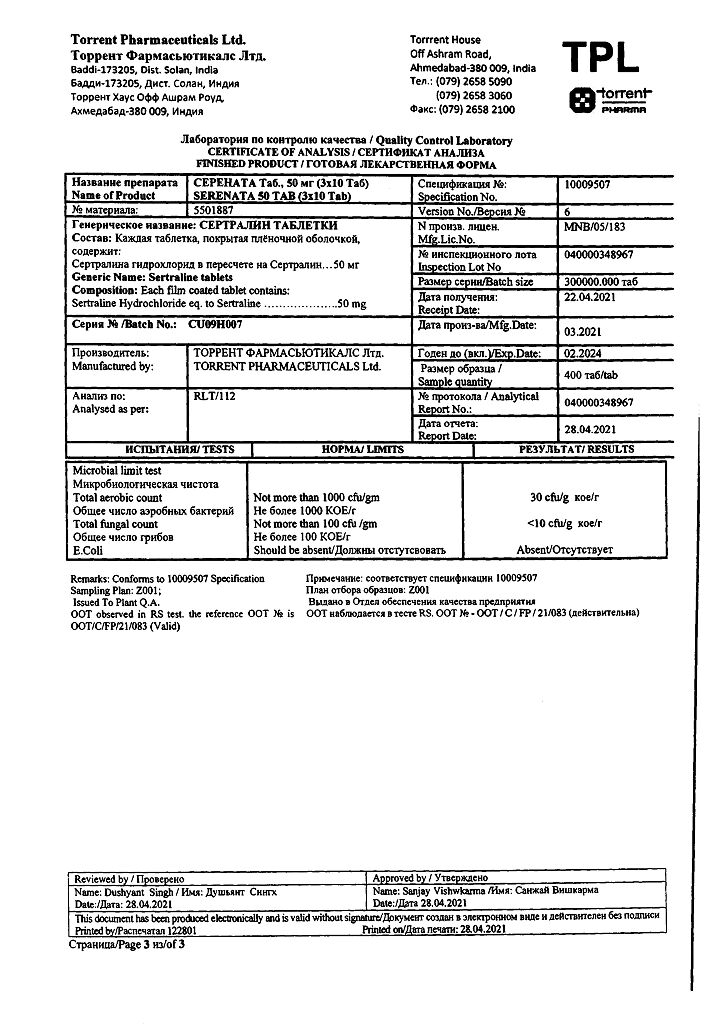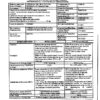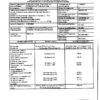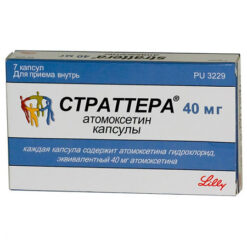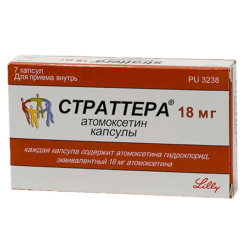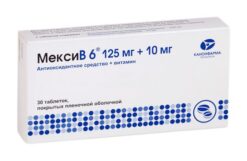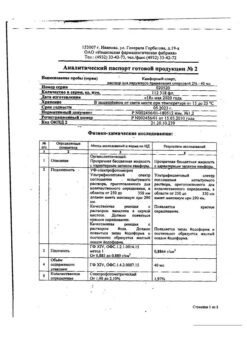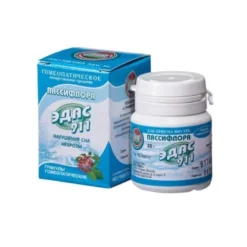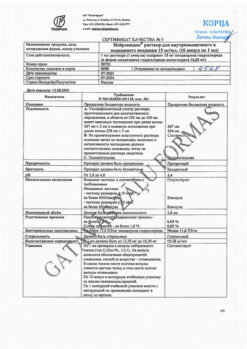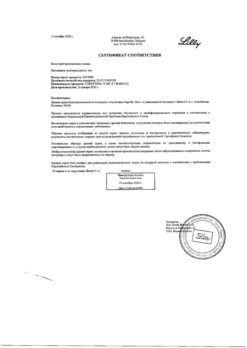No products in the cart.
Serenata, 50 mg 30 pcs
€9.75 €8.53
Out of stock
(E-mail when Stock is available)
Description
Serenate is an antidepressant.
Sertraline is a selective serotonin reuptake inhibitor (5-NT). It has a very weak effect on norepinephrine and dopamine reuptake. In therapeutic doses, sertraline blocks serotonin uptake by human platelets. It has no stimulant, sedative or anticholinergic effects. Sertraline has no affinity for muscarinic (cholinergic), serotoninergic, dopaminergic, adrenergic, histaminergic, GABA or benzodiazepine receptors.
Antidepressant effect is noted by the end of the second week of regular Sertraline administration, while the maximum effect is reached only after 6 weeks. Unlike tricyclic antidepressants, there is no increase in body weight when prescribed sertraline. Sertraline does not cause mental or physical drug dependence.
Pharmacokinetics
Sertraline absorption from the gastrointestinal tract is significant but slow. The maximum plasma concentration is reached 4.5-8.4 hours after oral administration. Equilibrium plasma concentration of Sertraline is reached within a week with a single daily dose. Bioavailability during food intake is increased by 25%, while the time to reach maximum concentration is shortened.
Distribution. Total binding of sertraline to plasma proteins is 98%. The volume of distribution is >20 l/kg.
Metabolism and excretion. Sertraline undergoes intensive metabolism during its first passage through the liver, undergoing N-demethylation. Its main metabolite, N-desmethylsertraline, is less active than the original compound. Metabolites are excreted with urine and feces in equal amounts. About 0.2% of sertraline is excreted unchanged by the kidneys. The half-life of the drug is 22-36 hours and does not depend on age or sex. For N-desmethylsertraline this figure is 62-104 hours.
The half-life of sertraline and the area under the plasma concentration curve (AUC) increases with impaired hepatic function. Regardless of the severity of renal impairment, the pharmacokinetics of sertraline does not change with its continuous use.
Sertraline penetrates into breast milk. There is no data on its ability to pass through the blood-brain barrier. Sertraline is not dialyzed.
Indications
Indications
Depression of various etiologies (treatment and prevention),
Obsessive-compulsive disorders (OCD)
Panic disorders (with or without agoraphobia).
Post-traumatic stress disorder (PTSD).
Pharmacological effect
Pharmacological effect
Serenata is an antidepressant.
Sertraline is a selective serotonin reuptake inhibitor (5-HT). It has a very weak effect on the reuptake of norepinephrine and dopamine. At therapeutic doses, sertraline blocks the uptake of serotonin by human platelets. It does not have stimulant, sedative or anticholinergic effects. Sertraline has no affinity for muscarinic (cholinergic), serotonergic, dopaminergic, adrenergic, histaminergic, GABA or benzodiazepine receptors.
The antidepressant effect is observed by the end of the second week of regular use of sertraline, while the maximum effect is achieved only after 6 weeks. Unlike tricyclic antidepressants, sertraline does not cause weight gain. Sertraline does not cause mental or physical drug dependence.
Pharmacokinetics
Absorption of sertraline from the gastrointestinal tract is significant, but occurs slowly. Maximum concentration in blood plasma is achieved 4.5-8.4 hours after taking the drug orally. The equilibrium concentration of sertraline in blood plasma is achieved within a week with a single daily dose. Bioavailability during meals increases by 25%, while the time to reach maximum concentration is shortened.
Distribution. The total binding of sertraline to plasma proteins is 98%. Volume of distribution >20 l/kg.
Metabolism and excretion. Sertraline undergoes extensive metabolism during its first passage through the liver, undergoing N-demethylation. Its main metabolite, N-desmethylsertraline, is less active than the parent compound. Metabolites are excreted in urine and feces in equal quantities. About 0.2% of sertraline is excreted unchanged by the kidneys. The half-life of the drug is 22-36 hours and does not depend on age or gender. For N-desmethylsertraline this figure is 62-104 hours.
The half-life of sertraline and the area under the plasma concentration curve (AUC) increase with impaired liver function. Regardless of the severity of renal failure, the pharmacokinetics of sertraline does not change with its continuous use.
Sertraline passes into breast milk. There is no data on its ability to pass through the blood-placental barrier. Sertraline is not dialysable.
Special instructions
Special instructions
Serenate should not be co-administered with an MAOI, or within 14 days of stopping treatment with an MAOI. Similarly, after discontinuation of sertraline, no MAOIs are prescribed for 14 days.
It should be noted that there is no sufficient experience with the use of sertraline in patients undergoing electroconvulsive therapy. The possible success or risk of this combination treatment has not been studied.
Patients suffering from depression are at risk for suicide attempts. This danger persists until remission develops. Therefore, from the start of treatment until the optimal clinical effect is achieved, patients should be under constant medical supervision.
Impact on the ability to drive vehicles and operate machinery:
The administration of sertraline, as a rule, is not accompanied by disturbances in psychomotor functions. However, its use simultaneously with other drugs can lead to impairment of attention and coordination of movements. Therefore, during treatment with sertraline, driving vehicles, special equipment or engaging in activities associated with increased risk is not recommended.
Active ingredient
Active ingredient
Sertraline
Composition
Composition
1 film-coated tablet contains:
active ingredient:
sertraline hydrochloride in terms of sertraline 50 or 100 mg;
excipients:
microcrystalline cellulose,
sodium carboxymethyl starch,
calcium hydrogen phosphate dihydrate,
polysorbate,
magnesium stearate;
hypromellose,
propylene glycol,
titanium dioxide
Pregnancy
Pregnancy
There are no controlled results of using sertraline in pregnant women, so the drug should be prescribed to them only if the expected benefit to the mother outweighs the potential risk to the fetus.
Women of reproductive age who are to be prescribed sertraline should be advised to use effective contraception.
Sertraline is found in breast milk and therefore treatment with this drug during breastfeeding is not recommended.
There is no reliable data on the safety of its use in this case.
If treatment is still necessary, it is better to stop breastfeeding.
Contraindications
Contraindications
Hypersensitivity to the active substance or other ingredients included in the drug Serenata,
combined use of sertraline and MAO inhibitors. When replacing one drug with another, you should refrain from taking antidepressants for 14 days.
combined use of sertraline with tryptophan or fenfluramine
unstable epilepsy,
children under 6 years of age;
pregnancy and lactation period.
With caution: organic diseases of the brain (including mental retardation), manic states, epilepsy, liver and/or kidney failure, weight loss, in children over 6 years of age.
Side Effects
Side Effects
Dry mouth, increased sweating, drowsiness, headache, dizziness, tremor, insomnia, anxiety, agitation, hypomania, mania, decreased appetite (rarely increased), up to anorexia, dyspeptic disorders (flatulence, nausea, vomiting, diarrhea), abdominal pain, weight loss, gait disturbances.
Weakness, redness of the skin, visual disturbances, ejaculation disorders, and decreased libido are also possible.
During treatment with sertraline, extrapyramidal disorders, dyskinesias, tremor, convulsions, menstrual irregularities, hyperprolactinemia, galactorrhea, skin rash, and occasionally erythema multiforme were noted. Motor disorders were more often observed in patients with indications of their presence in the anamnesis or with concomitant use of antipsychotic drugs.
Rare cases of withdrawal syndrome have been described when stopping treatment with sertraline. Paresthesia, hypoesthesia, symptoms of depression, hallucinations, aggressive reactions, psychomotor agitation, anxiety, or symptoms of psychosis may appear that cannot be distinguished from the symptoms of the underlying disease.
Laboratory test data: rarely – in 0.8% of observations; with long-term use – an asymptomatic increase in transaminase activity in the blood serum occurs. Discontinuation of the drug in this case leads to normalization of enzyme activity.
Transient hyponatremia may occur during treatment with sertraline. This develops more often in older patients, as well as when taking diuretics or a number of other drugs. This side effect is associated with the syndrome of inappropriate secretion of antidiuretic hormone.
Interaction
Interaction
Monoamine oxidase inhibitors (MAOIs). Severe complications are observed with the simultaneous use of sertraline and MAOIs (including selectively acting (selegiline) MAOIs and with a reversible type of action (moclobemide). The development of serotonin syndrome is possible. Similar complications, sometimes fatal, occur when MAOIs are prescribed during treatment with antidepressants that inhibit the neuronal uptake of monoamines or immediately after their withdrawal.
With the simultaneous use of selective neuronal reuptake inhibitors of serotonin and MAOIs, the following occur: hyperthermia, rigidity, myoclonus, lability of the autonomic nervous system (rapid fluctuations in parameters of the respiratory and cardiovascular system), changes in mental status, including increased irritability, severe agitation, confusion, which in some cases can turn into a delirious state or coma.
Medicines that depress the central nervous system and ethanol. The combined use of sertraline and substances that depress the central nervous system requires close attention, and the consumption of alcoholic beverages is prohibited during treatment with sertraline.
Coumarin derivatives – when co-administered with sertraline, a significant increase in prothrombin time is observed – in these cases it is recommended to monitor the prothrombin time at the beginning of treatment with sertraline and after its discontinuation.
Pharmacokinetic interaction
Sertraline binds to plasma proteins. Therefore, the possibility of its interaction with other protein-binding drugs (eg diazepam, tolbutamide and warfarin) must be taken into account.
Cimetidine: Concomitant use significantly reduces the clearance of sertraline.
Drugs metabolized by cytochrome P450 isoenzyme 2D6: long-term treatment with sertraline at a dose of 50 mg per day is accompanied by an increase in the concentration of desipramine.
Drugs metabolized by other cytochrome P450 enzyme systems. Experiments to study the interaction in vitro showed that the beta-hydroxylation of endogenous cortisol carried out by the isoenzyme CYP 3A3/4, as well as the metabolism of carbamazepine and terfenadine, do not change with long-term administration of sertraline at a dose of 200 mg per day. The plasma concentrations of tolbutamide, phenytoin and warfarin also do not change with long-term administration of sertraline at the same dose. Thus, we can conclude that sertraline does not inhibit the CYP2C9 isoenzyme.
Sertraline does not affect the concentration of diazepam in the blood serum, which indicates the absence of inhibition of the CHZ 2C19 isoenzyme. According to in vitro studies, sertraline has virtually no effect or minimal inhibition of the CYP 1A2 isoenzyme.
Lithium. The pharmacokinetics of lithium does not change with concomitant administration of sertraline. However, tremor is observed more often when they are used together. As with the administration of other selective neuronal serotonin reuptake inhibitors, the combined use of sertraline with drugs that affect serotonergic transmission (for example, lithium) requires increased caution.
Drugs affecting serotonergic transmission. When replacing one neuronal serotonin uptake inhibitor with another, there is no need for a washout period. However, caution is required when changing the course of treatment. Co-administration of tryptophan or fenfluramine with sertraline should be avoided.
Induction of microsomal liver enzymes. Sertraline causes minimal induction of liver enzymes. The simultaneous administration of sertraline and antipyrine at a dose of 200 mg leads to a significant decrease in the half-life of antipyrine, although this occurs in only 5% of cases.
Atenolol: When administered together, sertraline does not alter its β-adrenergic blocking effect.
Glibenclamide and digoxin: when sertraline was administered at a daily dose of 200 mg, no drug interactions with these drugs were detected.
Overdose
Overdose
Severe symptoms from an overdose of sertraline have not been identified, even when the drug is prescribed in large doses. However, when administered simultaneously with other drugs or ethanol, severe poisoning may occur.
Overdose can cause serotonin syndrome with nausea, vomiting, drowsiness, tachycardia, agitation, dizziness, psychomotor agitation, diarrhea, increased sweating, myoclonus and hyperreflexia.
Treatment: There are no specific antidotes. Intensive supportive care and constant monitoring of vital body functions are required.
Inducing vomiting is not recommended. The administration of activated carbon may be more effective than gastric lavage. The airway must be maintained. Sertraline has a large volume of distribution, and therefore increased diuresis, dialysis, hemoperfusion or blood transfusion may not be effective.
Storage conditions
Storage conditions
Store at temperatures below 25°C, out of the reach of children.
Shelf life
Shelf life
2 years.
Manufacturer
Manufacturer
Torrent Pharmaceuticals Ltd, India
Additional information
| Shelf life | 2 years. |
|---|---|
| Conditions of storage | Store at temperatures below 25 ° C, out of the reach of children. |
| Manufacturer | Torrent Pharmaceuticals Ltd, India |
| Medication form | pills |
| Brand | Torrent Pharmaceuticals Ltd |
Related products
Buy Serenata, 50 mg 30 pcs with delivery to USA, UK, Europe and over 120 other countries.

